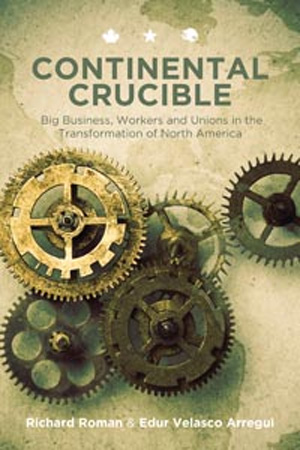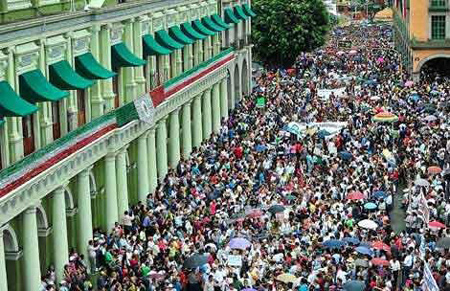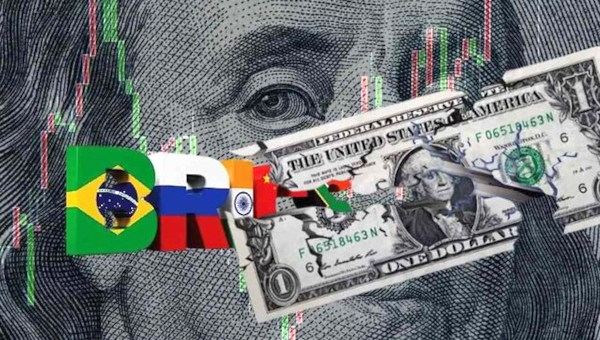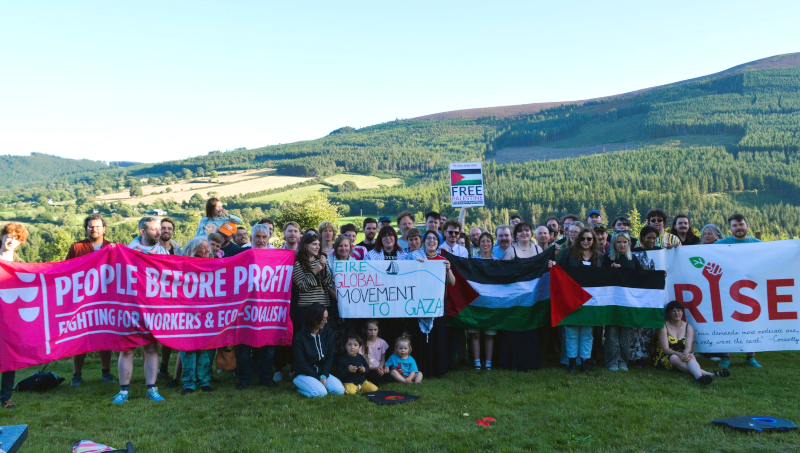The two articles that follow are part of a debate on the prospects and problems of building international working-class solidarity and struggle. They focus on these issues for the case of North America, a continent bound together through NAFTA, continental economic integration, overlapping labour markets, and U.S.-Canadian unions. Dan La Botz’ article presents a very positive but critical commentary on Richard Roman and Edur Velasco Arregui’s book, Continental Crucible: Big Business, Workers, and Unions in the Transformation of North America. La Botz questions what he sees as an overly optimistic analysis of prospects for the working class movement in North America. The reply by Roman and Velasco Arregui argues for a cautious optimism, an optimism based both on characteristics of the present moment of globalized capitalism and the historical ties between the working classes of North America. This debate seeks to contribute to both the rebuilding of the Left and the building of a class-wide, continent-wide and eventually international, fight against capitalism, two tasks that are inseparably intertwined.
As the title suggests, Continental Crucible: Big Business, Workers and Unions in the Transformation of North America by Richard Roman and Edur Velasco looks simultaneously at corporate political strategy, the unions’ responses, and the effects of industrial relocation and worker migration. It is this (as I wrote in a blurb for the book) that makes this book unique and so valuable. We are asked to look at class dynamics and class struggle and their impact on industrial investment policies and demographics throughout North America in a holistic way that is seldom attempted. The authors argue that these dynamics have laid the foundation for a new and necessary stage of international working-class solidarity both in North America and in the world. Yet, while the fundamental approach is correct, it seems to me that they tend at times to exaggerate the existing level of struggle, to misunderstand the complexity of the situation of Mexican workers in the U.S., and to overestimate the likelihood of revolutionary developments in Mexico in the near future.

Before turning to my doubts, let me first explain the approach of this book and point out its strengths. Continental Crucible provides an essential framework for thinking about North American labour issues in terms of business policy, union strategy and migration patterns. And it traces in detail the ways in which business organizations in Canada, Mexico and the United States, each for their own reasons and somewhat differently, eventually arrived at the common policy of adopting neoliberal strategies and a vision of continental economic integration. The U.S. Business Roundtable, the Canadian Business Council on National Issues, and the Mexican Business Coordinating Council turned to neoliberalism and economic integration as a way of responding to a decline in profitability, confronting labour militancy and imposing labour discipline, ending older social pacts and in the broadest sense changing the national cultures to put competition and consumerism at the center. Though we cannot go into those differences here, the book deals with the initial differences between each of the national strategies that ultimately put them on the same road.
Business Turns to NAFTA
Taken together, these strategies eventually converged to create the North American Free Trade Agreement (NAFTA), a treaty that, while most beneficial to U.S. corporations, also offered important incentives and benefits to both Canadian and Mexican business as well. The result of these economic changes generally and of NAFTA in particular was even more uneven economic development among the three countries and regions within them, leading to increased wage competition, downward harmonization, and more migration.
The Canadian, Mexican and U.S. labour movements each responded differently to these developments and failed to come up with a common and coordinated response, so a new North America political economy was created that now provides the terrain of struggle. In the authors’ view, two historical developments laid the basis for labour collaboration in North America today: first, the creation in the twentieth century of the International Unions – really U.S.-based unions – that have local union affiliates in the United States and Canada; second, the combination of U.S. plant relocation to Mexico and Mexican migration to the United States, which means that millions of Mexican workers are employed by U.S. companies on both sides of the border. The U.S. labour movement is the hinge, linked to Canada through the International Unions and to Mexico through investment and migration. At the same time, women have entered the workforce and the migrant streams in enormous numbers in all three countries, changing the existing patterns of employment and implicitly challenging patriarchy and the existing gender hierarchies.
Roman and Velasco argue that though these developments have been going on now for more than 30 years, the labour unions continue to operate on antiquated and obsolete strategies derived from national and nationalistic principles, and from narrow trade union conceptions of the role of unions. The result has been that unions have failed both to develop a class-wide model of struggle in their own countries and have also failed to create the international coordination necessary to confront big business on the continent. The authors assert that the development of overlapping labour markets, continental production chains, and massive migration laid the basis for a new kind of labour solidarity and struggle. They see hope in the strategic alliances between unions such as the United Electrical Workers Union (UE) in the U.S. and the Authentic Labour Front (FAT) in Mexico, and in the attempt by the United Steel Workers (representing U.S. and Canadian workers) and the Mexican Miners and Metal Workers (Los Mineros) to create a new transnational union.
Transforming Unions?
They argue that if we are to build a continental labour movement the unions need a new vision as well as a new strategy.
“Solidarity can only be built on the bases of a struggle for upward harmonization, which would require regulating capitalist investment and labour markets, tasks that would require challenging the power of big business or struggling for a transformation of the economy from capitalism to one of socialist democracy. Either would require a powerful workers’ movement, rooted in communities and workplaces, with a strategy of struggle and an alternative vision of society; a vision that rejects competition and embraces solidarity.” (p. 105)
This book then is not simply about cooperation and coordination between existing unions, but a call for a profoundly democratic, anti-racist and anti-sexist transformation of the existing unions to make them genuine fighting organizations of the continental working-class. It is this complex and combined analysis of business, labour, migration and gender relations that makes this book so powerful and important.
Nevertheless, the book still raises doubts for me. Like many of us on the left, Roman and Velasco, it seems to me, have a tendency to exaggerate the size, scope and character of the contemporary class struggle. The opening sentences of the book read: “The crucible of North American transformation is heating up, but its outcome is far from clear. There is a growing clash between those pushing to continue the corporate agenda and the movements of resistance.” (p. 1). I wish I could agree with this – but I cannot. The capitalists in North America continue to push the neoliberal agenda, but there seems to me at the moment to be little significant resistance. The level of class struggle in the U.S. is at an all-time low and Canada’s not much better.
Regarding Mexico, the authors’ claim that “Mexico is the only country whose very institutional framework could be fundamentally challenged in the short and medium run,” and that we can expect a “growing insurgency” (p. 113) strikes me as wrong. They assert that “…the working-class of Mexico still has revolutionary, collectivist and class-conscious rhetoric and traditions in spite of the ceaseless neoliberal cultural offensive. The repertoire of popular protest in Mexico continues to have insurrectionary and revolutionary images and options.” (p. 114)
The authors seem to want to say that Mexico is in a pre-revolutionary situation, though they carefully calibrate their language. Having closely followed Mexican working-class, trade union and political developments for more than 25 years, I have become convinced that Mexico’s supposedly revolutionary traditions, rhetoric, and images actually inhibit the development of a serious and realistic revolutionary politics appropriate for today. Mexico sees many protests, but few major conflicts; it is the only nation in Latin America that has never had a general strike. Moreover, in Mexico the Institutional Revolutionary Party that just returned to power under Enrique Peña Nieto is on a roll, either coopting or sweeping away its opponents. Mexico authoritarian regime, its corruption and violence, inhibit class struggle; workers mostly have been losing. I do not find the claim that Mexico will be the spark for a new wave of North American class struggle to be convincing. I will be delighted to be proven wrong by subsequent developments.
I am also not convinced that the U.S. International Unions, with their locals in the U.S. and Canada, represent the basis for any sort of international solidarity movement. There has always been a simmering resentment among Canadian workers against the U.S. unions, leading some 20 years ago to a series of splits, the most important being the Canadian Auto Workers (CAW) leaving the United Auto Workers. I am not sure that those tensions have completely disappeared. Moreover, the International Unions are dominated by a bureaucratic caste of officials that has proven unwilling and unable to lead their members in struggle in the two separate nations. I see no reason to believe that the International Unions would be more successful in an international struggle for which they have shown little aptitude so far.
Finally, I find Roman and Velasco’s treatment of Mexican immigration to the United States to be too simplistic. They argue that, “The curse of poverty follows them to their ‘new’ life.” (p. 62) While it is true as they argue that Mexican immigrants are part of a labour reserve army that experiences particularly intense exploitation, suffers racial discrimination, and often endures poor living conditions, some immigrants also achieve relative success in new jobs and new communities and see their children find other opportunities, while many assimilate partially or wholly to American society. This is, of course, why immigrants come to the United States: because work pays more, and in addition – especially if one has papers (and many do) and certainly for the second generation – there is less repression and one has more democracy and more rights than in Mexico. The authors paint the immigrant condition with too broad a brush and too monochromatically.
Their misunderstanding of the Latino immigrants in the United States appears clearly in a statement like the following:
“The extreme poverty and racism that undocumented workers have been enduring has now spread to large sectors of the rest of the Latino population. It is this increasingly common situation of poverty that has united Latinos, with or without documents, and gave the immigrant protests of 2006 and 2010 a radical character.” (p. 82)
In my view, the predominantly Latino immigrant demonstrations of 2006 represented a broad demand for dignity and democratic rights and achieved significance from the mass participation of Latinos, many leaving work to participate, giving some of the demonstrations the character of a kind of Latino general strike (or “A Day without a Mexican”); nevertheless, the demonstrators carrying the flags of their own nations and that of the United States, coming from the churches, soccer clubs, and labour unions, never had “a radical character” – if what we mean by radical is a challenge to the established economic, social and political order. Immigrants by and large were demanding green cards and a path to citizenship, the right to participate in American society, not a fundamental change in American society.
Despite these reservations about their reading of the political and social climate in the three countries, and especially in Mexico, and though I differ with them about the Mexican immigrant experience here, I believe that the complex analysis they present and the conclusions that they draw from their analysis of business, unions, and migration are fundamentally correct. As they argue, we need to build rank-and-file movements to make unions in all three countries more democratic and militant. We need to fight racism and sexism in society, at work and in the unions. And we need to build international solidarity. All of those interested in understanding the nature of the problems we face in taking on the capitalist class and building a new continental labour movement will find this book essential. •
Dan La Botz is editor of Mexican Labor News and Analysis, the most important source about labour struggles in Mexico and is co-editor of New Politics, where both of these articles were first published.
Yes, We Can
Response to “Creating a Transcontinental North American Working Class Movement” by Dan La Botz
Richard Roman and Edur Velasco Arregui
We hoped that our book, Continental Crucible, would open up a discussion of the future of the North American Left and labour movement, a discussion that is urgent in the face of the relentless capitalist offensive of the last forty years. Dan La Botz’s generous, thoughtful, and critical review of our book, Continental Crucible, advances that discussion in important ways and we hope that others will join in the discussion. We argue that workers’ struggles, while remaining grounded locally, need to simultaneously expand their geographical terrains to match those of capital, that these struggles must move beyond sectionalism and economism toward class-wide, anti-racist, feminist, inclusive, internationalist and transformational goals and that unions themselves have to be transformed into participatory, democratic, and class-political organizations. These are daunting but unavoidable challenges that face the Left and the working-class. We also argue that transformed unions – and certainly not unions as they presently exist – are essential for any effective challenge to the power of Capital.
Challenging the Rule of Capital
The absence of a significant revolutionary left in all three NAFTA countries creates a major obstacle to this necessary transformation of unions. But that is the unfortunate and difficult reality. The transformation of existing unions and the rebuilding of a revolutionary, non-sectarian left will have to proceed simultaneously if either is to be successful. But there is no other way to effectively challenge the rule of capital and its determination to level downward the working conditions, standards of living, and environmental conditions in all three countries, a determination consciously cultivated by the leading political organizations of the capitalist class in all three countries, as we discuss in Chapters 1-4.
The mass protest movements that have erupted world-wide have, in general, lacked a consciously organized working-class core with the ability to give the movement organizational solidity and political direction. The absence of this working-class core speaks to the failure of the revolutionary left as well as the cooptation, corruption and sectional economism of much of the union movement. The labour movement has responded with ineffective, rearguard actions while the capitalist class has been transforming the system.
The mass anti-neoliberal protest movements (the Quebec students, the Occupy movement in the U.S., the anti-media duopoly/electoral fraud youth movement in Mexico), can at best slow down the neoliberal offensive at certain points or win victories, albeit important, (tuition raise reversal in Quebec) that leave intact the power of capital to renew its offensive when these movements have ebbed in energy and organization. Only a solidly institutionalized movement based on the working-class and with a left transformatory perspective can give solidity and durability to these movements of students, the middle sectors, and workers.

We think that there’s basic agreement on these points. Our differences reside both in Dan’s pessimism and in some of his specific reading of our views. Where Dan seems to see relative hopelessness at this moment, we see possibilities, possibilities that face great obstacles, but possibilities nevertheless. There is a murmur of discontent in important sectors of all three countries that occasionally erupts in significant struggles. There have been important episodes of resistance, impressive but fragmented – the Oaxaca uprising of 2006, the resistance of miners in Mexico against great odds, the Madison insurgency, the Quebec student movement. Indeed, these encouraging episodes float in a sea of continuing defeats. There are many good reasons for pessimism. But it’s crucial to cultivate the seeds of resistance – as Dan does in his practice – even in a historical moment of great defeats. Popular discontent, even if not expressed in actions, is being kept alive by the relentlessness of the capitalist offensive and the deliberate slamming shut of the doors of reform. There is a real potential for the emergence of radical, class-based struggles against the capitalist offensive but the path will not be easy. It will require the development of a non-sectarian radical left with a class struggle orientation.
Before summing up our arguments, we’d like to explore three areas in which Dan presents critiques of our perspective on the current situation. Dan argues that we “tend at times to exaggerate the existing level of struggle, to misunderstand the complexity of the situation of Mexican workers in the U.S., and to overestimate the likelihood of revolutionary developments in Mexico in the near future.” We’ll comment on these critiques one by one.
“Exaggerate Existing Level of Struggle”
The level of labour resistance to the capitalist offensive is at a nadir. The forty year assault by Capital and the short-sighted responses of labour have brought the union movement to an incredibly weak position. Our statement in the introduction that the clash between the capitalist offensive and the “forces of resistance” was heating up was a bit exaggerated – or premature, we hope.
But, nevertheless, we are more optimistic than Dan about the potential for resistance. The most important reason for optimism is the very success of the capitalist offensive. In the last forty years, both in periods of economic expansion and economic crisis, the capitalist class has been successful in creating more inequality, more human suffering, more poverty, more environmental destruction alongside a consumerist ideology of higher living standards. The capitalist offensive will continue and workers will respond individually and collectively. The heterogeneity within the working-class means that there will be a variety of responses that will vary in different moments and different contexts. Despair and feelings of personal failure will mingle with anger and rebelliousness not only in the class but in the minds of individual workers. The rebelliousness for some could turn into reactionary radicalization or class-conscious left radicalization. There is danger and opportunity.
This “American (and Mexican and Canadian) Dream” – which has been a sustaining factor in capitalist domination as well as providing important underpinning for narrow, economistic unionism, is in process of destruction by the very success of the capitalist offensive. The despair that people feel will make them open to new alternatives. In the case of the U.S. and, to a lesser degree Canada, it could make sections of the working-class open to right-wing, racist, anti-immigrant demagoguery. This alternative is very unlikely for the Mexican working-class because of its different ethno-racial make-up and history of racial victimization in both Mexico and the U.S. as well as the very different character of Mexican popular culture. But for Canada and the U.S., the absence of both a working-class oriented Left and class struggle unionism leaves the door open for a reactionary radicalization of the working-class. But the despair felt by workers in all three countries only creates a potential for left radicalization of the working-class. It requires ideological-political leadership to win over workers to the notions that their suffering is the result of capitalism and not of this or that political party or immigrants, definitions widely offered by sections of the media. The potential of left radicalization of the working-class needs to be politically nurtured by the interconnected rebuilding of the Left with a working-class orientation and the transformation of the labour movement in ways that we discuss and on which we all are in agreement.
We are also more optimistic than Dan because of the surprising – and generally unexpected – insurgencies of recent years, insurgencies that have both been inspiring and at the same time, have contained severe limitations. We are in a period both of great working-class defeats and massive popular insurgencies. These insurgencies nevertheless represent a re-entry throughout the world of the masses as political actors. They have (re)established a model of mass direct action as a model of struggle, a model that is crucial not only for the struggle against authoritarian institutions but also has pointed to a necessary alternative to the compromised politics of much of the electoral left. The Arab Spring, the Quebec student movement against tuition increases, the 2012 Mexican movement against electoral fraud and the media, the Madison occupation, the Greek and other European fightbacks against the collective punishment of austerity, the Turkish uprising, and most recently the Brazilian mass insurgency. These insurgencies show the potential for the emergence of mass and unexpected resistance to neoliberalism, though these issues have been intertwined with or submerged within broader, more diverse, and sometime ambiguous demands. These insurgencies have inspired each other. While the cases of insurgency are very heterogeneous, we can suggest that the challenge is the same as mentioned above – the development of a Left with a class struggle and revolutionary perspective within these broad and diverse movements.
The internal diversity of these movements has been both a strength in mobilizing vast and heterogeneous social sectors and a limitation in consolidating these movements or achieving social transformation. These movements, in general, have lacked leadership that could create cohesion and clear direction, a leadership with a mass of rank and file leaders within the movement. A radical working-class movement could provide that leadership and the solidity of organizational structure within these diverse movements. But unions and the working-class more broadly have lacked this seasoned base and transformational vision to play that role. Its absence has left many of these mobilizations subject to ideological cooptation and/or simply withering away. This argument, of course, would need qualification and greater specificity given the variety of cases.
“But the economistic sectionalism which was successful for some sectors of the working-class in the post WWII “golden age” of capitalism has proven totally inadequate to even defend those segments of the working-class in this new period, let alone the rest of the working-class.”
The labour movements in Canada, Mexico and the U.S., with their lack of transformational vision, their present politics, and their existing organization are not able to play this role. The limitations of the labour movement in Mexico have important differences with the limitations of unions in the U.S. but even the best unions in all three countries have limitations that derive from bureaucratization, sectionalism, and economism as well as from the intrinsic tensions of unions within capitalism. The necessity of bargaining within the system, even when your goal is to transform the system, creates dilemmas and tensions whose progressive resolution requires an overall vision of strategy and politics. But the economistic sectionalism which was successful for some sectors of the working-class in the post WWII “golden age” of capitalism has proven totally inadequate to even defend those segments of the working-class in this new period, let alone the rest of the working-class. In fact, this narrow form of economistic unionism has facilitated the playing off of sections of the working-class against each other.
We discuss these issues at length in Chapter 8 of our book in the sections, “The Limits of Presently Existing Unionism,” “The Limits of Presently Existing Solidarity,” and “Transforming Unionism, Transforming Solidarity, Transforming Society.” We argue that the working-class is the necessary central backbone to any transformational struggle in all three NAFTA countries, all of which have a vast, if very heterogeneous, working-class majority. We argue that unions cannot play a leading role in transformational struggles without transforming themselves. These limits of unions and the necessity of their transformation are a key part of our discussion, as Dan notes. This is why we agree with Dan’s pessimism about presently existing unionism and specifically about U.S.-Canadian international unions as they now exist. But we maintain a cautious optimism that the relentless assault of capital and the models and embers of resistance provide a potential that could lead to a new workers’ movement. We argue that the larger unions in the U.S. and Canada have the organizational and financial wherewithal to play a key role in the development of a new workers’ movement in all of North America – though as currently constituted, they lack the politics and the will. An upsurge of rank and file militancy is necessary to challenge these old structures and politics.
“Misunderstand the Complexity of Mexican Workers in the U.S.”
Dan argues that our characterization of the protests of Latino immigrants lacks complexity and that we’re wrong to view them as having a radical character. He qualifies this critique by saying “if what we mean by radical is a challenge to the established economic, social and political order. Immigrants…were demanding…the right to participate in American society, not a fundamental change in American society.” We would argue that, while the demands did not have an explicitly radical character, they nevertheless had – and have – a tacitly radical character. There are different potentials in the non-revolutionary demands of the immigrant movement. Reformist demands have radical and radicalizing potential if the system cannot grant them or, if their granting has the potential, to radicalize the struggle. The radical and radicalizing potential of demands lies not simply in the demand but in the context in which it is made. Just as with trade union struggles that can only achieve limited successes within capitalism, they have the potential to radicalize the working-class movement in their course of struggle.
There is great heterogeneity in the Latino community and some immigrants do achieve relative success, as Dan points out. However, the proportion of the immigrant community that is able to be successful has been sharply diminished by the structural changes to the economy brought about by the corporate offensive as compared to earlier generations of immigrants. The whole downward harmonization of the labour market has sharply decreased possibilities of mobility for immigrants as well as hopes for a better future for their children. And, yes, there is improvement in absolute poverty levels for many immigrants but that improvement comes at a very high human cost. While health and safety conditions for all workers have deteriorated, the greatest deterioration has been for those on the bottom end of the labour market where immigrants are concentrated. And the very act of migration is an act fueled by hope for a better life in the U.S. as well as desperation about possibilities at home. These raised expectations smack up against the reality of the neoliberal offensive. Raised expectations, disappointing realities, super-exploitative conditions, all create a potential for radicalization.
The immigrant rights’ movement was a very broad movement and, as in all very broad movements, there is, of course, a struggle for hegemony in the movement between liberal, reformist forces, socially conservative forces, and left radical forces just as is the case with the broad insurgent movements mentioned above and the labour movement more broadly. And, as in those cases, the weakness of the Left is the Achilles’ heel of the struggle.
“Overestimate the Likelihood of Revolutionary Developments
in Mexico in the Near Future”
Mexico is not in a pre-revolutionary situation; it is in a deep organic crisis, a catastrophic equilibrium and an implosion and/or explosion of the regime is quite likely in the near future. In fact, it can be argued that an implosion is well underway and that an explosion may well be brewing under the surface, an explosion that may only emerge in fragmented ways and therefore be subject to containment, cooptation and defeat but also may spread. That implosion and/or explosion could lead to a variety of outcomes including a more brutal and more authoritarian regime and/or an intensified and more brutal internal war.
We are more optimistic than Dan about the potential for a workers’ insurgency in Mexico in the coming period. There are numerous obstacles and problems but the continuing and now speeded-up neoliberal transformation of the economy as well as the continuing repression and denial of workers’ rights have closed off reformist solutions that, along with repression, have previously worked so well in 20th century Mexico. Contrary to the systematically promoted myth of an economic renaissance in Mexico, the economy continues in semi-stagnation with deteriorating standards of living for most of the population (Cypher 2013). The terrible and worsening reality for most of the Mexican population does not guarantee a workers’ insurgency but increases the potential for one.
The weakness of the union movement as well as of the revolutionary left in Mexico does not preclude popular uprisings but makes their success more problematic. Again, the challenge is how to simultaneously rebuild a revolutionary left with a working-class orientation and a workers’ movement, of which unions would be a key component. We also believe that radical traditions of popular insurgency and class struggle are still alive in important sectors of the working-class in spite of their manipulation and abuse by the regime and the union officialdom. A renewed workers’ movement in Mexico will unavoidably clash with the very structure of the political regime as the whole strategy of the regime is low wages and intensified worker exploitation based on repressive labour control. Workers, with rare exceptions, can only make significant and durable gains in organization, wages, and conditions by transforming the regime.
A workers’ insurgency in Mexico, if at all successful, would immediately be attacked by both the Canadian and U.S. regimes. The imperial interventions as well as the insurgency itself would have popular reverberations among the vast Latino population of the United States. An insurgent workers’ movement, even if contained or defeated, could have a big and radicalizing influence on the Mexican working-class in the U.S., especially in the context of the continuing repression of unions and wage cutting in the USA.
We believe that a workers’ insurgency in Mexico could be the spark for a new wave of North American class struggle. But there is no guarantee that there will be a big wave of workers’ insurgency in Mexico or that it will have a wider continental impact. But there is a significant potential for a popular explosion in Mexico along the lines of ones that have recently occurred in other parts of the world. The example of Oaxaca 2006 though limited by its local character and tolerated by the national regime for tactical reasons for a period, shows how quickly the combination of militancy around trade union demands by the teachers’ of Oaxaca combined with repression by the regime to produce a genuine popular uprising that controlled Oaxaca City for five months (Roman and Velasco).
Conclusion
There are reasons to despair about the prospects for the workers’ movement and the Left in North America at the present moment. But there are also strong reasons for a cautious optimism. Both the obstacles in the way of a revival of the labour movement and the Left as well as the pressing necessity of such a revival – and transformation – are powerful. The challenges are enormous but not impossible. The labour movements of North America and the North American Left can be and must be revived and transformed. Yes, we can. •





